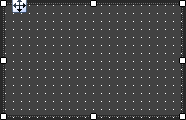

A widget panel is a control on a Custom Panel that links all controls inside its borders to one or more curves of a graph.
The entire widget panel is linked to the graph, so individual controls do not (and cannot) link to individual parameters; individual control assignments are made in the "assignments" property of the widget panel.
See "How a Widget Panel works" for more information.
To set up a widget panel:
Add a widget panel to the Custom Panel
Link the widget panel to the desired graph using graph collaboration.
Add controls to the widget panel
Assign those graph parameters to the controls
Graphs can be managed in the Custom Panel designer and, once the Custom Panel is activated, utilized by the end user.
Overlapping controls, especially graphs, can result in unexpected behavior and/or appearance of controls. Use caution if you choose to overlap controls.
|
|
OPTIONS / INSTRUCTIONS |
NOTES / EXAMPLE |
General |
|
|
|
Control Info |
Shows control type |
Read only |
|
Graph Name |
Allows graph to be named |
|
|
Type |
Select which type of EQ to be used for collaboration |
|
|
Widget Panel Name |
The name of the widget panel |
Used for graph collaboration |
|
Assignments |
Allows editing of assignments on Widget Panel |
|
Appearance |
||
|
Location |
Control location (in pixels) of the control on the Custom Panel Change X (horizontal) and Y (vertical) values in relation to upper left corner You can also drag the control to a different location |
|
|
Size |
Control size (in pixels) Change width and height values You can also re-size the control manually
|
|
|
Paint Style |
Background paint style of the control SolidBrush - solid background GradientBrush - gradient fill background |
|
|
Gradient Mode |
Type of gradient fill if gradient is selected in Paint Style Click to select type of gradient |
Horizontal, Vertical, Forward Diagonal, Backward Diagonal |
|
Background Color |
Color of the background Brings up the Select Color window |
Default color is black |
|
Gradient Color Start |
Beginning gradient color if gradient is selected in Paint Style Brings up the Select Color window |
|
|
Gradient Color End |
Ending gradient color if gradient is selected in Paint Style Brings up the Select Color window |
|
|
Background Image |
Background graphic of control Brings up the Select Image File window |
|
|
Background Image Layout |
How the background image displays |
None (default layout - upper left corner) Tiled, Center, Stretch or Zoom |
|
Border Style |
Click to select border style |
|
|
Draw Border |
Whether or not the control has a border |
Checked = Yes Unchecked = No |
|
Rounded Corners |
Whether or not to round the corners |
Checked = Yes Unchecked = No |
|
Corner Radius |
The radius of the corners |
The larger the number, the larger the curve |
|
Tab Index |
If tab stop is set to true, determines the position of the control in the tab order |
|
|
Tab Stop |
Specifies whether the control appears in the tab order |
Checked = Appear Unchecked = Doesn't Appear |
Controls on a widget panel are similar to other Custom Panel controls except that they are tied to elements of a graph. The widget panel controls the band or channel that is specified on the selector panel of an activated panel.
NOTE: The entire widget panel is linked to the graph, so individual controls do not (and cannot) link to individual parameters; individual control assignments are made in the "Assignments" property of the widget panel.
For example, a fader can control one parameter of one band on one channel.
Even if multiple parameters are added to the fader, all of the parameters change to the same value:
If, however, a fader is added to a widget panel that is linked to a graph (and a selector panel), the fader can control ALL bands individually with one control of the graph:
Once a new band is selected on the selector panel, the fader controls the same parameter on that band as well